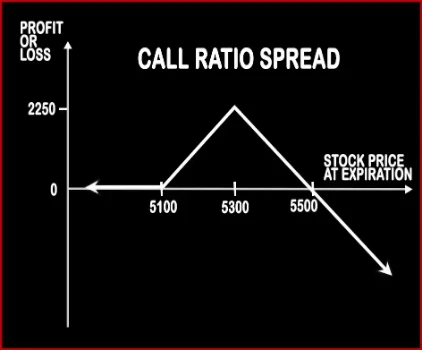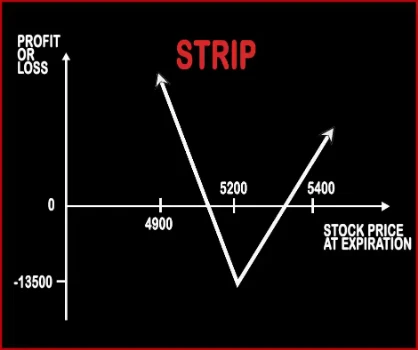Compare Strategies
| RATIO CALL SPREAD | STRIP | |
|---|---|---|

|

|
|
| About Strategy |
Ratio Call Spread Option StrategyAs the name suggests, a ratio of 2:1 is followed i.e. buy 1 ITM Call and simultaneously sell OTM Calls double the number of ITM Calls (In this case 2). This strategy is used by trader who is neutral on the market and bearish on the volatility in the near future. Here profits will be capped up to the premium amount and risk will be potentially unlimited since he is |
Strip Option StrategyStrip Strategy is the opposite of Strap Strategy. When a trader is bearish on the market and bullish on volatility then he will implement this strategy by buying two ATM Put Options & one ATM Call Option, of the same strike price, expiry date & underlying asset. If the prices move downwards then this strategy will make more profits compared to short straddle because of the .. |
RATIO CALL SPREAD Vs STRIP - Details
| RATIO CALL SPREAD | STRIP | |
|---|---|---|
| Market View | Neutral | Neutral |
| Type (CE/PE) | CE (Call Option) | CE (Call Option) + PE (Put Option) |
| Number Of Positions | 3 | 3 |
| Strategy Level | Beginners | Beginners |
| Reward Profile | Limited | Unlimited |
| Risk Profile | Unlimited | Limited |
| Breakeven Point | Upper Breakeven Point = Strike Price of Short Calls + (Points of Maximum Profit / Number of Uncovered Calls), Lower Breakeven Point = Strike Price of Long Call +/- Net Premium Paid or Received | Upper Breakeven Point = Strike Price of Calls/Puts + Net Premium Paid, Lower Breakeven Point = Strike Price of Calls/Puts - (Net Premium Paid/2) |
RATIO CALL SPREAD Vs STRIP - When & How to use ?
| RATIO CALL SPREAD | STRIP | |
|---|---|---|
| Market View | Neutral | Neutral |
| When to use? | This strategy is used by trader who is neutral on the market and bearish on the volatility in the near future. Here profits will be capped up to the premium amount and risk will be potentially unlimited since he is selling two calls. | When a trader is bearish on the market and bullish on volatility then he will implement this strategy. |
| Action | Buy 1 ITM Call, Sell 2 OTM Calls | Buy 1 ATM Call, Buy 2 ATM Puts |
| Breakeven Point | Upper Breakeven Point = Strike Price of Short Calls + (Points of Maximum Profit / Number of Uncovered Calls), Lower Breakeven Point = Strike Price of Long Call +/- Net Premium Paid or Received | Upper Breakeven Point = Strike Price of Calls/Puts + Net Premium Paid, Lower Breakeven Point = Strike Price of Calls/Puts - (Net Premium Paid/2) |
RATIO CALL SPREAD Vs STRIP - Risk & Reward
| RATIO CALL SPREAD | STRIP | |
|---|---|---|
| Maximum Profit Scenario | Strike Price of Short Call - Strike Price of Long Call + Net Premium Received - Commissions Paid | Price of Underlying - Strike Price of Calls - Net Premium Paid OR 2 x (Strike Price of Puts - Price of Underlying) - Net Premium Paid |
| Maximum Loss Scenario | Price of Underlying - Strike Price of Short Calls - Max Profit + Commissions Paid | Net Premium Paid + Commissions Paid |
| Risk | Unlimited | Limited |
| Reward | Limited | Unlimited |
RATIO CALL SPREAD Vs STRIP - Strategy Pros & Cons
| RATIO CALL SPREAD | STRIP | |
|---|---|---|
| Similar Strategies | Variable Ratio Write | Strap, Short Put Ladder |
| Disadvantage | • Unlimited potential loss. • Complex strategy with limited profit. | Expensive., The share price must change significantly to generate profit., High Bid/Offer spread can have a negative influence on the position. |
| Advantages | • Downside risk is almost zero. • Investors can book profit from share prices moving within given limits. • Trader can maximise profit when the share closes at the upper breakeven point. | Profit is generated when the share price changes in any direction., Limited loss., The profit is potentially unlimited when share prices are moving. |